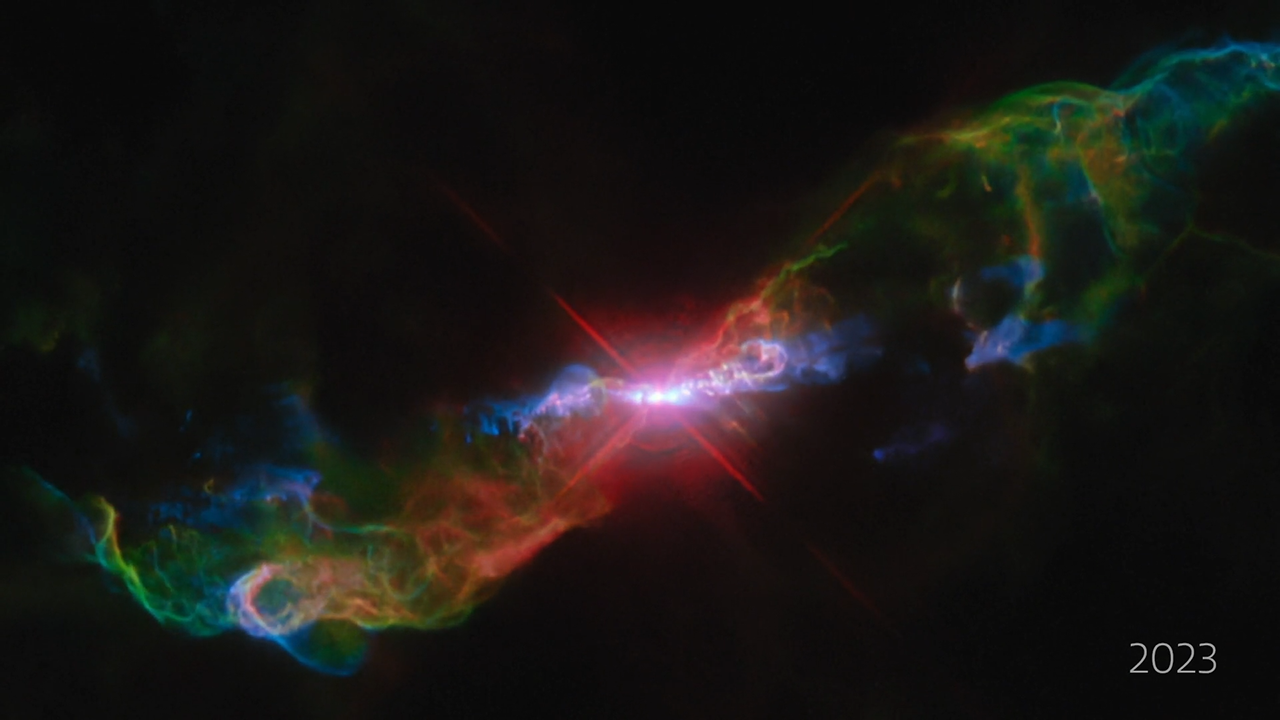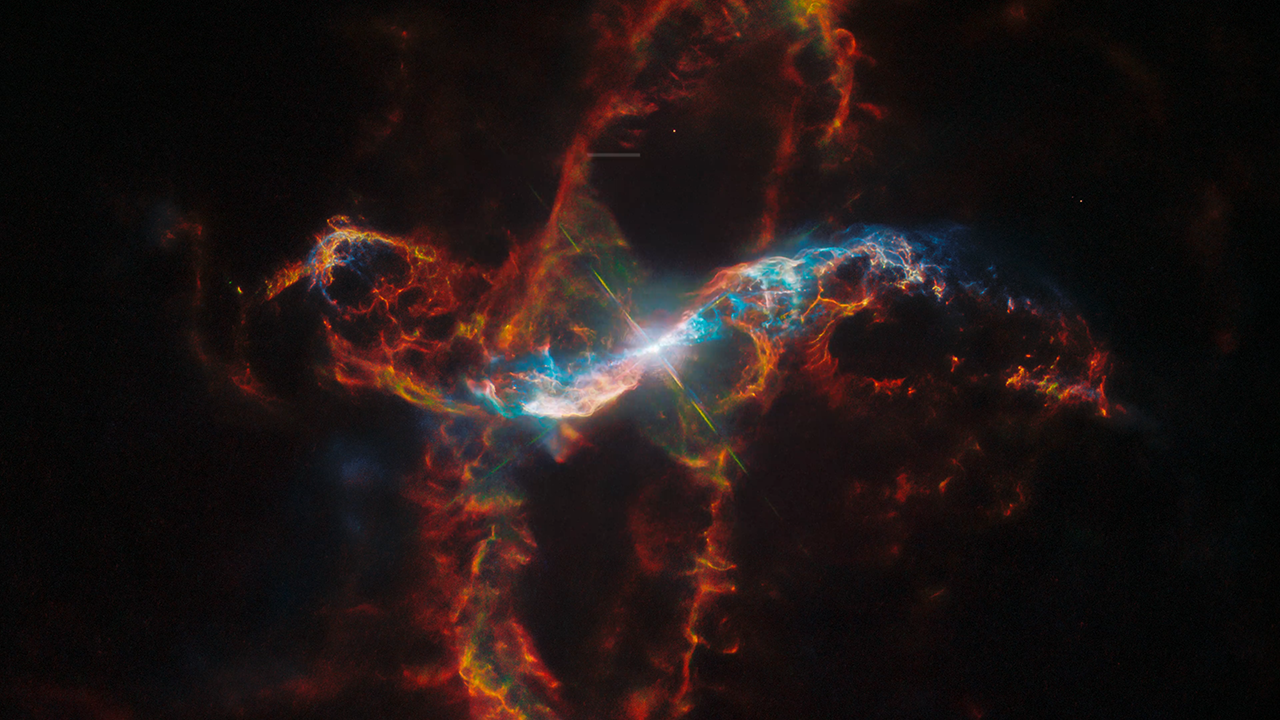1 min read
R Aquarii (WFC3 Image)

NASA's Hubble Space Telescope has provided a dramatic and colorful close-up look at one of the most rambunctious stars in our galaxy, weaving a huge spiral pattern among the stars.
Located approximately 700 light-years away, a binary star system called R Aquarii undergoes violent eruptions that blast out huge filaments of glowing gas. The twisted stellar outflows make the region look like a lawn sprinkler gone berserk. This dramatically demonstrates how the universe redistributes the products of nuclear energy that form deep inside stars and jet back into space.
R Aquarii belongs to a class of double stars called symbiotic stars. The primary star is an aging red giant and its companion is a compact burned-out star known as a white dwarf. The red giant primary star is classified as a Mira variable that is over 400 times larger than our Sun. The bloated monster star pulsates, changes temperature, and varies in brightness by a factor of 750 times over a roughly 390-day period. At its peak the star is blinding at nearly 5,000 times our Sun's brightness.
When the white dwarf star swings closest to the red giant along its 44-year orbital period, it gravitationally siphons off hydrogen gas. This material accumulates on the dwarf star's surface until it undergoes spontaneous nuclear fusion, making that surface explode like a gigantic hydrogen bomb. After the outburst, the fueling cycle begins again.
This outburst ejects geyser-like filaments shooting out from the core, forming weird loops and trails as the plasma emerges in streamers. The plasma is twisted by the force of the explosion and channeled upwards and outwards by strong magnetic fields. The outflow appears to bend back on itself into a spiral pattern. The plasma is shooting into space over 1 million miles per hour – fast enough to travel from Earth to the Moon in 15 minutes! The filaments are glowing in visible light because they are energized by blistering radiation from the stellar duo.
Hubble first observed the star in 1990. R Aquarii was resolved into two very bright stars separated by about 1.6 billion miles. The ESA/Hubble team now has made a unique timelapse of R Aquarii's dynamic behavior, from observations spanning from 2014 to 2023. Across the five images, the rapid and dramatic evolution of the binary star and its surrounding nebula can be seen. The binary star dims and brightens due to strong pulsations in the red giant star.
The scale of the event is extraordinary even in astronomical terms. Space-blasted material can be traced out to at least 248 billion miles from the stars, or 24 times our solar system's diameter. Images like these and more from Hubble are expected to revolutionize our ideas about such unique stellar "volcanoes" as R Aquarii.
Extended Description and Image Alt Text
Extended Description
A bright binary star surrounded by a colorful nebula on the black background of space. The star in the center is a large white spot surrounded by a circular glow. It has a large, X-shaped set of diffraction spikes around it. The nebula extends far above, below, left and right of the star in long, arcing shapes made of thin, multicolored filaments — mostly red and greenish colors, but lit in a bright cyan near the star where its light illuminates the gas.
Image Alt Text
A bright binary star surrounded by a colorful nebula on the black background of space. The star in the center is a large white spot surrounded by a circular glow. It has a large, X-shaped set of diffraction spikes around it. The nebula extends far above, below, left and right of the star in long, arcing shapes made of thin, multicolored filaments — mostly red and greenish colors, but lit in a bright cyan near the star where its light illuminates the gas.
About the Object
- R.A. PositionR.A. PositionRight ascension – analogous to longitude – is one component of an object's position.23:43:49.46
- Dec. PositionDec. PositionDeclination – analogous to latitude – is one component of an object's position.-15:17:04.20
- ConstellationConstellationOne of 88 recognized regions of the celestial sphere in which the object appears.Aquarius
- DistanceDistanceThe physical distance from Earth to the astronomical object. Distances within our solar system are usually measured in Astronomical Units (AU). Distances between stars are usually measured in light-years. Interstellar distances can also be measured in parsecs.About 1,000 light-years away
About the Data
- Data DescriptionData DescriptionProposal: A description of the observations, their scientific justification, and the links to the data available in the science archive.
Science Team: The astronomers who planned the observations and analyzed the data. "PI" refers to the Principal Investigator. - InstrumentInstrumentThe science instrument used to produce the data.WFC3/UVIS
- Exposure DatesExposure DatesThe date(s) that the telescope made its observations and the total exposure time.2013-2023
- FiltersFiltersThe camera filters that were used in the science observations.F502N, F631N, F656N, F658N
- Object NameObject NameA name or catalog number that astronomers use to identify an astronomical object.R Aquarii
- Object DescriptionObject DescriptionThe type of astronomical object.Symbiotic binary star system
- Release DateOctober 16, 2024
- Science ReleaseNASA’s Hubble Sees a Stellar Volcano
- CreditNASA, ESA, Matthias Stute, Margarita Karovska, Davide De Martin (ESA/Hubble), Mahdi Zamani (ESA/Hubble)

These images are a composite of separate exposures acquired by the Hubble Space Telescope using the WFC3/UVIS instrument. Several filters were used to sample narrow wavelength ranges. The color results from assigning different hues (colors) to each monochromatic (grayscale) image associated with an individual filter. In this case, the assigned colors are: Blue: F631N, Cyan: F502N, Green: F656N, Red: F658N
Related Images & Videos

Evolution of R Aquarii from 2014-2023 (Timelapse)
This video features five frames spanning from 2014 to 2023 of R Aquarii, a symbiotic binary star that lies approximately 700 light-years from Earth in the constellation Aquarius. This is a type of binary star system consisting of a white dwarf and a red giant that is surrounded...

Evolution of R Aquarii from 2014-2023 (Timelapse 2)
This video features five frames spanning from 2014 to 2023 of R Aquarii, a symbiotic binary star that lies approximately 700 light-years from Earth in the constellation Aquarius. This is a type of binary star system consisting of a white dwarf and a red giant that is surrounded...
Share
Details
Claire Andreoli
NASA’s Goddard Space Flight Center
Greenbelt, Maryland
claire.andreoli@nasa.gov































